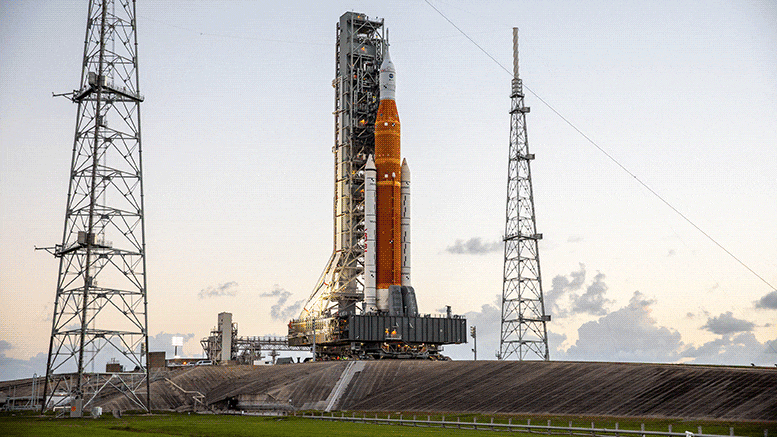
El cohete del Sistema de Lanzamiento Espacial (SLS) de la NASA y la nave espacial Orion con su Módulo de Servicio Europeo llegan a la plataforma de lanzamiento 39B en el Centro Espacial Kennedy de la NASA en Florida, EE. UU., el 4 de noviembre de 2022. La misión Artemis I será la primera prueba del SLS y Orion y la Unidad de Servicio Europea. Crédito: NASA/Kim Shevlet
El cohete Artemis I mega Moon está en la plataforma de lanzamiento en[{” attribute=””>NASA’s Kennedy Space Center in Florida. This powerful Space Launch System (SLS) rocket is getting ready to launch the Orion spacecraft and its European Service Module. The first opportunity for launch is November 16 at 1:04 a.m. EST/local time (07:04 CET, 06:04 GMT).
Artemis I is the first mission in a large program to send astronauts around and on the Moon sustainably. This uncrewed first launch will see the Orion spacecraft travel to the Moon, enter an elongated orbit around our satellite, and then return to Earth. The Orion spacecraft is powered by the European-built module that supplies electricity, propulsion, fuel, water, and air in addition to keeping the spacecraft operating at the right temperature.

Artemis I mission overview. Orion is NASA’s next spacecraft to send humans into space and is part of the Artemis program. It is designed to send astronauts farther into space than ever before, beyond the Moon and to the lunar Gateway. Credit: ESA–K. Oldenburg
Artemis to the Moon
The European Service Modules are made from components supplied by over 20 companies in ten European Space Agency (ESA) Member States and the United States. As the first European Service Module sits atop the SLS rocket on the launchpad, the second is only 8 km (5 miles) away, as it is currently being integrated with the Orion crew capsule for the first crewed mission – Artemis II. The third and fourth European Service Modules – that will power astronauts to a Moon landing – are in production in Bremen, Germany.

Contributions in Europe for the European Service Module that is powering the Artemis missions around the Moon. Credit:
ESA–K. Oldenburg
The Artemis program is an international endeavor to build a permanent outpost around and on the Moon. Modules for the lunar Gateway are being built in the United States and Europe, with the first European module – International Habitat – in production in Turin, Italy, and set for launch on the fourth Artemis mission alongside the Orion spacecraft.
The first Artemis launch this week is without humans, but three mannequins have been placed in the spacecraft’s seats to conduct scientific research. Fitted with more than 5600 sensors, two mannequins will measure the amount of radiation astronauts could be exposed to in future missions with unprecedented precision. ESA is also including active radiation dosimeters in the Crew Module to get more data on how radiation levels change on a mission to the Moon – building on the leadership developed over decades of radiation research on the International Space Station.

Logo for the first European Service Module (ESM) that is powering NASA’s Orion spacecraft to send humans into space and the Moon as part of the Artemis program. Credit: ESA
Dates
With a November 16 launch, the three-week Artemis I mission would end on December 11 with a splashdown in the Pacific Ocean. The European Service Module detaches from the Orion Crew Module before splashdown and burns up harmlessly in the atmosphere, its job complete after taking Orion to the Moon and back safely.
Backup Artemis I launch dates include November 19. Watch the launch live on ESA Web TV.
La nave espacial Orion equipada con el Módulo de Servicio Europeo volará más lejos de la Tierra que cualquier nave espacial clasificada por humanos antes. Este video brinda una descripción general de la primera misión, sin astronautas, de Artemis, con un enfoque en el Módulo de servicio europeo de la Agencia Espacial Europea que opera la nave espacial. La nave espacial volará sobre la luna, utilizando la gravedad lunar para ganar velocidad y propulsarse a 70.000 kilómetros de la luna, casi medio millón de kilómetros de la Tierra, más lejos de lo que cualquier ser humano ha viajado, ya que se impulsará en un vuelo retrógrado lejano. girar alrededor de la luna. En su viaje de regreso, Orión realizará otro sobrevuelo de la Luna antes de regresar a la Tierra. El viaje total tomará alrededor de 20 días y termina con el agua fluyendo hacia el Océano Pacífico sin la ESU: se separa y se quema en la atmósfera sin causar daño. Crédito: ESA – Agencia Espacial Europea

“Futuro ídolo adolescente. Explorador amigable. Alborotador. Especialista en música. Practicante ávido de las redes sociales. Solucionador de problemas”.





More Stories
Compensar el sueño los fines de semana puede reducir el riesgo de enfermedad cardíaca en una quinta parte: estudio | Cardiopatía
¿Cómo se hicieron los agujeros negros tan grandes y rápidos? La respuesta está en la oscuridad.
Una estudiante de la Universidad de Carolina del Norte se convertirá en la mujer más joven en cruzar las fronteras del espacio a bordo de Blue Origin